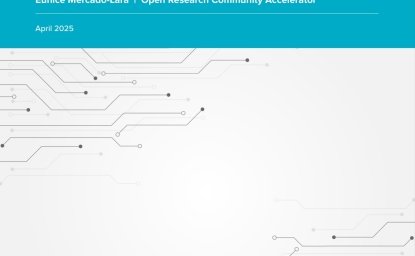by Lauren Crowley
Dr. Francis Collins, Director of the National Human Genome Research Institute at the National Institutes of Health, spoke Tuesday March 6 about genomics and its impact on medicine and society in a Wilson Center Director's Forum. This was the first forum in a series sponsored by the Wilson Center's new Foresight and Governance Project.
Until recently the Human Genome Project (HGP) was largely unknown and poorly understood by most of the public. This all changed with the highly publicized announcement last summer that 90 percent of the human DNA sequence had been mapped. According to Collins, today that percentage stands at 96 percent.
Definitions and Fast Facts
A genome is all the DNA in a plant or animal cell. DNA, a chemical that takes the shape of a double helix, sits in the nucleus of the cell and can be described as an instruction book for human biology written in a language that has only four letters in its alphabet, ACGT. DNA stores the information needed to build a human in the sequence of these letters. Each human cell contains some 3 billion of these letters of the DNA code. According to Collins, reading this code letter by letter would take a person 32 years to complete. Recent advances in computer technology and DNA sequencing approaches have allowed the breaking of the genetic code to rapidly move forward.
Medical Benefits of the Study
The dominant motivation behind the project has been its medical benefits. While the environment plays a role in the development of any illness, virtually all diseases have some hereditary contribution. Sorting out this hereditary component from environmental determinants has been one of the major challenges in medicine.
To Collins, now that the sequencing of the human genome is almost complete, the real work is just beginning. The challenge now is to interpret this information—specifically to determine the genes that are involved in these susceptibilities to disease and to then use this information diagnostically and therapeutically so that treatments can be more precisely successful than the current therapies. This information may one day be used to identify what patients will respond to a drug in a beneficial way, what patients won't, and who is going to have side effects that will make them wish they had never taken the drug to begin with.
According to Collins, "The idea is to use the gene to shine a bright light on the real mechanism of what the disease is all about and to derive from that a therapy that is much closer to the magic bullet that we all hope to see." Pharmaceutical companies have already started down this path in exciting ways.
The Shared Inheritance
The Human Genome Project has been an international effort from the beginning, as it should be. "This information is the shared inheritance of all humankind," Collins said. The enormity of the task required a collaborative effort and was made possible by a shared belief in the importance of the goal. The dedication of this international consortium is also responsible for the project's accelerated completion, nearly five years ahead of the original schedule.
Key Findings
The new findings published in the February 2001 issue of Nature magazine indicate that humans have only about 31,000 key genes, not much more than the 19,000 genes in roundworms, or 20,000 to 25,000 in some plants. The findings also revealed that human DNA is 99.9 percent the same from person to person, regardless of ethnic group, which further supports the fact that racial categories are a social construct. "This is not just about a molecule called DNA, it's about the human race," Collins remarked.
Global Accessibility
The international consortium has always made this data available to the public online, placing no restrictions on its access. Using this information, the medical community has linked 40 genes to specific diseases such as cystic fibrosis, and hundreds more are expected in the future. The Human Genome Project's home on the Internet is http://www.nhgri.nih.gov.
Social, Legal, and Ethical Consequences
Former director of the Human Genome Project and co-discoverer of DNA, Jim Watson, declared at the outset that the identification of the social, legal, and ethical issues that arise from genetic research are part and parcel of the project. In fact, 5 percent of the project's budget is dedicated to researching these issues, representing the largest ever investment in research on ethical issues. Collins maintained that the resolution of these issues will require continual government attention, education, and a productive dialogue among the various disciplines involved and the public.
One of the issues of chief concern is genetic discrimination, where an employer or health insurance company can terminate employment or insurance coverage based on disease risk determined from genetic testing. As everyone has glitches in their DNA, this will have universal effects. The current HGP recommendation is that predictive genetic information not be used in discussions about health care or in the workplace.
Role of Education
If genomics is to become mainstream in medical treatment, public education is key. In an effort to educate the public, the project has developed an education kit, "The Human Genome Project: Exploring Our Molecular Selves," including an interactive CD ROM, a video, manual, and instruction booklet aimed at high school biology teachers. This kit, available in both English and Spanish, is available free, at the following web address: http://www.genome.gov/Pages/EducationKit/.
Genetic Testing and Life Span
One of the questions that comes to mind in light of this research is its future impact on health and the human life span. According to Collins, by 2010 it should be possible to inexpensively screen individuals for their susceptibility to a variety of diseases and use that information to develop life style and preventive strategies. Collins indicated that genetics research could provide new means to allow people to live healthier and more productive lives into the late 80s and 90s. He was more sanguine about the potential to increase human life span, though this may happen within the next 30 to 40 years.

Science and Technology Innovation Program
The Science and Technology Innovation Program (STIP) serves as the bridge between technologists, policymakers, industry, and global stakeholders. Read more


Maternal Health Initiative
Housed within the Wilson Center's Environmental Change and Security Program, the Maternal Health Initiative (MHI) leads the Wilson Center’s work on maternal health, global health equity, and gender equality. Read more

Explore More
Browse Insights & Analysis
The Bybit Heist: What Happened & What Now?


